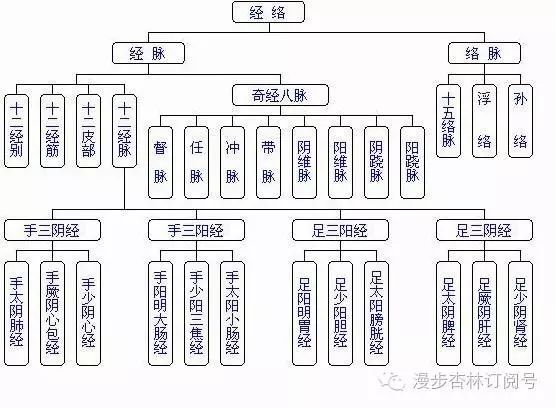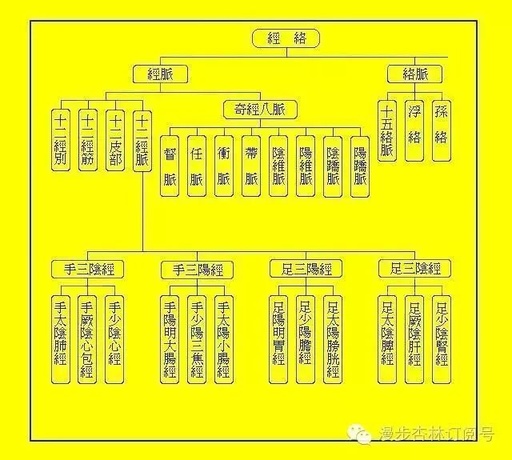(1) Meaning of Divergent Channels
The term “Divergent Channels” refers to the twelve divergent channels that branch from the twelve primary meridians. They are distributed in the chest, abdomen, and head, connecting the exterior and interior meridians while enhancing the relationship with the organs. They are considered a system of channels included within the scope of the twelve primary meridians, hence referred to as “the proper channels that diverge.”
(2) Pathways of Divergent Channels
The pathways of the twelve divergent channels begin from the limbs, penetrating into the internal organs, and then ascend to the superficial areas of the head and neck, connecting the exterior and interior. The locations of “divergence, convergence, exit, and entry” are closely related to the pathways of the twelve primary meridians, but there are significant differences in the direction of flow. For example, the pathway of the Hand Three Yin Meridians flows from the chest to the hand, while the divergent channel diverges from the axilla, penetrating into the thoracic cavity before ascending to the head, converging with the Hand Three Yang Meridians. The pathway of the Hand Three Yang Meridians flows from the hand to the head, while the Hand Three Yang Divergent Channel diverges from the axilla, penetrating into the internal organs before ascending to the head. Similarly, the pathway of the Foot Three Yin Meridians flows from the foot to the chest (abdomen), while the Foot Three Yin Divergent Channel flows from the foot to the head; the pathway of the Foot Three Yang Meridians flows from the head to the foot, while the Foot Three Yang Divergent Channel flows from the foot to the head.
The differences between the twelve divergent channels and the primary meridians are mainly reflected in their pathways, characterized by “divergence, convergence, exit, and entry.” Each divergent channel branches from its corresponding primary meridian, referred to as “divergence” (bie), enters the thoracic and abdominal cavities referred to as “entry” (ru), exits at the head and neck referred to as “exit” (chu), and connects with the exterior and interior meridians referred to as “convergence” (he). The three Yin and three Yang channels of the hands and feet together form six pairs, known as “the Six Harmonies.”
1. Foot Taiyang – Foot Shaoyin (One Convergence)
(1) Foot Taiyang Divergent Channel
Divergence Entry: In the groin, one branch reaches five cun below the buttocks, diverging into the anus.
Divergence Pathway: Belongs to the Bladder, disperses to the Kidney, and connects to the heart, linking to the root of the tongue.
Exit Convergence: Exits from the back and emerges at the nape.
Converges with: Foot Taiyang.
(2) Foot Shaoyin Divergent Channel
Divergence Entry: In the groin.
Divergence Pathway: One branch diverges and ascends to the Kidney, connecting at the fourteenth vertebra, linking to the Dai Mai; the direct pathway ascends from the Kidney to the root of the tongue.
Exit Convergence: Exits again at the nape.
Converges with: Foot Taiyang.
2. Foot Shaoyang – Foot Jueyin (Two Convergences)
(1) Foot Shaoyang Divergent Channel
Divergence Entry: Ascends around the hip, merging with the Foot Jueyin meridian at the hairline, with the diverging branch entering between the ribs.
Divergence Pathway: Circulates in the chest, belongs to the Gallbladder, disperses to the Liver, ascends to the heart, and travels up to the throat.
Exit Convergence: Exits at the jaw, disperses to the face, connecting to the eyes at the outer canthus.
Converges with: Foot Shaoyang.
(2) Foot Jueyin Divergent Channel
Divergence Entry: Diverges from the dorsum of the foot, ascending to the hairline.
Divergence Pathway: Merges with the pathway of the Foot Shaoyang divergent channel.
Converges with: Foot Shaoyang.
3. Foot Yangming – Foot Taiyin (Three Convergences)
(1) Foot Yangming Divergent Channel
Divergence Entry: Ascends to the hip, penetrating into the abdomen.
Divergence Pathway: Belongs to the Stomach, disperses to the Spleen, ascends to the heart, and circulates to the throat.
Exit Convergence: Exits from the mouth, ascending to the upper part of the nasal column and below the eye socket, also connecting to the eyes.
Converges with: Foot Yangming.
(2) Foot Taiyin Divergent Channel
Divergence Entry: Diverges up to the hip.
Divergence Pathway: Merges with the pathway of the Foot Yangming divergent channel, linking to the throat and penetrating to the root of the tongue.
Converges with: Foot Yangming.
4. Hand Taiyang – Hand Shaoyin (Four Convergences)
(1) Hand Taiyang Divergent Channel
Divergence Entry: Diverges from the shoulder, entering the axilla.
Divergence Pathway: Travels to the heart, connecting to the Small Intestine.
Converges with: Hand Taiyang.
(2) Hand Shaoyin Divergent Channel
Divergence Entry: Diverges between the two tendons in the axilla.
Divergence Pathway: Belongs to the heart, ascending to the throat.
Exit Convergence: Exits at the face, converging at the inner canthus of the eye.
Converges with: Hand Taiyang.
5. Hand Shaoyang – Hand Jueyin (Five Convergences)
(1) Hand Shaoyang Divergent Channel
Divergence Entry: Diverges from the crown, entering the supraclavicular fossa.
Divergence Pathway: Descends to the Sanjiao, dispersing in the chest.
Converges with: Hand Shaoyang.
(2) Hand Jueyin Divergent Channel
Divergence Entry: Diverges three cun below the axilla at the Tianchi point.
Divergence Pathway: Enters the chest, linking to the Sanjiao.
Exit Convergence: Travels along the throat, exiting behind the ear, and finishing at the occiput.
Converges with: Hand Shaoyang.
6. Hand Yangming – Hand Taiyin (Six Harmonies)
(1) Hand Yangming Divergent Channel
Divergence Entry: Ascends from the hand, circulating between the chest and breast, diverging at the Jianyu point, entering the Tianzhu bone.
Divergence Pathway: Descends from the supraclavicular fossa into the Large Intestine, ascending to connect with the Lung, and further up along the throat.
Exit Convergence: Exits from the supraclavicular fossa.
Converges with: Hand Yangming.
(2) Hand Taiyin Divergent Channel
Divergence Entry: Diverges from the axilla, preceding the Hand Shaoyin channel.
Divergence Pathway: Enters the Lung, dispersing to the Large Intestine.
Exit Convergence: Exits from the supraclavicular fossa, circulating along the throat.
Converges with: Hand Yangming.
(3) Physiological Functions of Divergent Channels
The six Yang divergent channels among the twelve all pass through their corresponding interior organs, such as “the divergent channel of Foot Shaoyang disperses to the Liver,” “the divergent channel of Foot Yangming disperses to the Spleen,” and “the divergent channel of Foot Taiyang disperses to the Kidney.” The six Yin divergent channels also pass through their respective organs. This not only indicates that the twelve divergent channels are connected to the organs, playing a nourishing role within the body, but also highlights the mutual relationship between the Yin and Yang channels. Their distribution and interrelationship are more intricate than the communication of the exterior and interior tissues through the collaterals in the limbs.
The twelve divergent channels assist the twelve primary meridians in connecting the internal organs and the body surface, reflecting the “divergence, convergence, exit, and entry” relationship of the three Yin and three Yang channels of the hands and feet, and their mutual infusion, together with the twelve primary meridians, fifteen collaterals, and eight extraordinary meridians, forming a system of Qi and blood circulation. Since each meridian has its own divergent channel, the range of treatment for a specific acupoint is not limited to the pathway of the meridian, which specifically illustrates the function of the divergent channels.
The twelve divergent channels are not recorded in the “Neijing” for any pathological conditions. However, the divergent channels significantly influence the therapeutic properties of certain acupoints. The symptoms that each meridian acupoint can treat may not be reached by the meridian’s pathway, but rather by the divergent channel’s pathway. For instance, the acupoints Chengshan, Chengjin, and Heyang of the Foot Taiyang Bladder Meridian can treat hemorrhoids, but the pathway of the Bladder Meridian does not reach the anus, while the pathway of the divergent channel is “five cun below the buttocks, diverging into the anus.”


↓↓↓ Scan to follow “Walking in the Apricot Forest“, to gain more knowledge about Traditional Chinese Medicine


